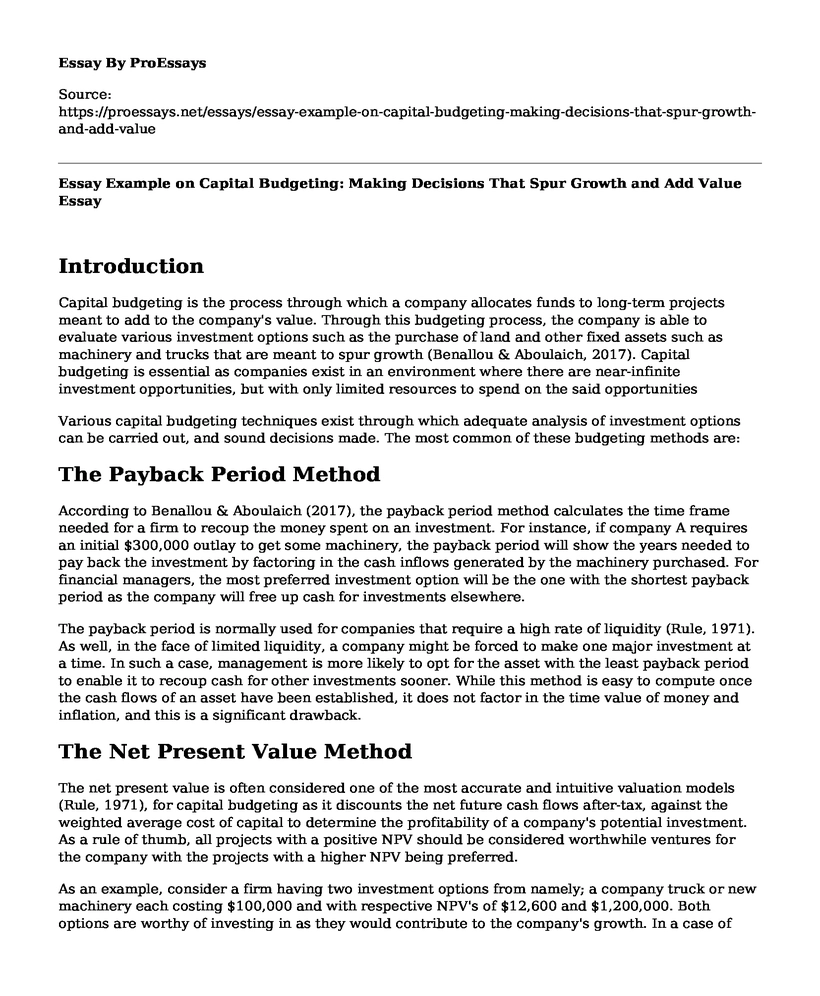Introduction
Capital budgeting is the process through which a company allocates funds to long-term projects meant to add to the company's value. Through this budgeting process, the company is able to evaluate various investment options such as the purchase of land and other fixed assets such as machinery and trucks that are meant to spur growth (Benallou & Aboulaich, 2017). Capital budgeting is essential as companies exist in an environment where there are near-infinite investment opportunities, but with only limited resources to spend on the said opportunities
Various capital budgeting techniques exist through which adequate analysis of investment options can be carried out, and sound decisions made. The most common of these budgeting methods are:
The Payback Period Method
According to Benallou & Aboulaich (2017), the payback period method calculates the time frame needed for a firm to recoup the money spent on an investment. For instance, if company A requires an initial $300,000 outlay to get some machinery, the payback period will show the years needed to pay back the investment by factoring in the cash inflows generated by the machinery purchased. For financial managers, the most preferred investment option will be the one with the shortest payback period as the company will free up cash for investments elsewhere.
The payback period is normally used for companies that require a high rate of liquidity (Rule, 1971). As well, in the face of limited liquidity, a company might be forced to make one major investment at a time. In such a case, management is more likely to opt for the asset with the least payback period to enable it to recoup cash for other investments sooner. While this method is easy to compute once the cash flows of an asset have been established, it does not factor in the time value of money and inflation, and this is a significant drawback.
The Net Present Value Method
The net present value is often considered one of the most accurate and intuitive valuation models (Rule, 1971), for capital budgeting as it discounts the net future cash flows after-tax, against the weighted average cost of capital to determine the profitability of a company's potential investment. As a rule of thumb, all projects with a positive NPV should be considered worthwhile ventures for the company with the projects with a higher NPV being preferred.
As an example, consider a firm having two investment options from namely; a company truck or new machinery each costing $100,000 and with respective NPV's of $12,600 and $1,200,000. Both options are worthy of investing in as they would contribute to the company's growth. In a case of limited resources; however, investing in machinery should be the first priority due to its far superior NPV.
The Internal Rate of Return Method
The internal rate of return calculates the discount rate that would have the net present value (NPV) of an asset return to zero. As the discount rate is inversely proportional to the net present value, an increasing discount rate over the years would result in increasingly uncertain cash flows in the future, making the asset less valuable.
Accordingly, the general rule of thumb is:
- Accept the project when: The IRR is greater than The Cost of Capital.
- Reject the project when: The IRR is lesser than The Cost of Capital
With a project having a calculated IRR of 15%, the firm should only consider the project when the discount rate they use for their cashflow models is less than 15%.
The Modified Internal Rate of Return Method
The modified internal rate of return acts to improve the internal rate of return by introducing the assumptions that all positive cash inflows from a project will be reinvested by the firm to cover the financing costs of the asset. According to Sivaruban (n.d), this technique assumes a more realistic approach to how companies finance their investments and calculate their profitability.
The MIRR provides a useful way through which projects of unequal size can be evaluated (Sivaruban, n.d). As well, the technique is designed to eliminate the need for multiple IIR that would be necessary when comparing multiple investment options. With a modified rate of return, one solution can be generated that compares all available investment options on their merits.
Conclusion
In conclusion, every investment option needs to be evaluated on its merits to ascertain that it will make a profit, rather than a loss, for the company. What's more, the finance department of a company also considers the projected returns of an asset to determine the period within which the company shall have recouped its investment in the asset. All these objectives are made possible with the above capital budgeting techniques.
References
Rule, N. P. V. (1971). Capital Budgeting. (NPV)
Sivaruban, S. A Study On Management Accounting Practices in PNG SMEs Sector.
Benallou, O., & Aboulaich, R. (2017). Improving Capital Budgeting Through Probabilistic Approaches. Review of Pacific Basin Financial Markets and Policies, 20(03), 1750018.
Cite this page
Essay Example on Capital Budgeting: Making Decisions That Spur Growth and Add Value. (2023, Feb 23). Retrieved from https://proessays.net/essays/essay-example-on-capital-budgeting-making-decisions-that-spur-growth-and-add-value
If you are the original author of this essay and no longer wish to have it published on the ProEssays website, please click below to request its removal:
- Two Investment Projects Analysis
- Case Study on Leo and Julie Retirement Plans
- Mauritius Economics - Essay Sample
- Financial Management Challenge Case Study
- Essay Example on Financial Future of Medicare
- Essay Example on Nokia's Fall: An Analysis of Global Factors
- Cutback Mgmt: Addressing Strategies in Resource Scarcity Paper Example







